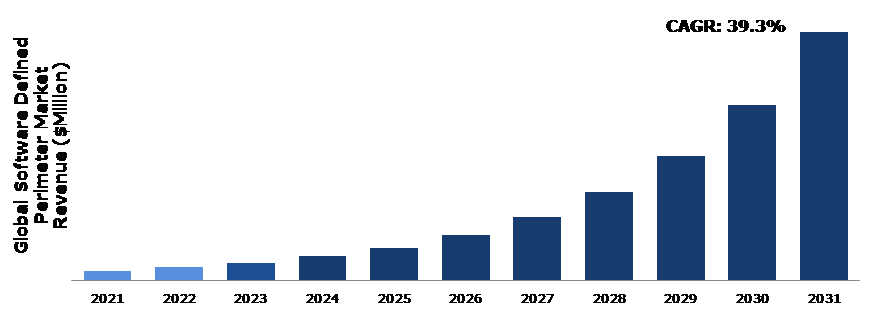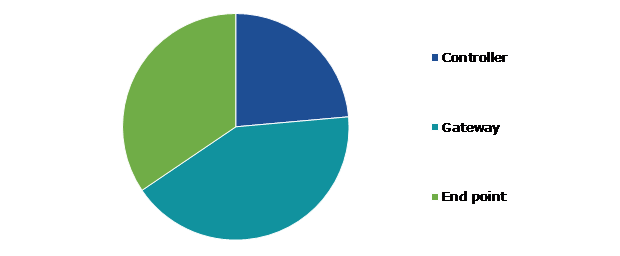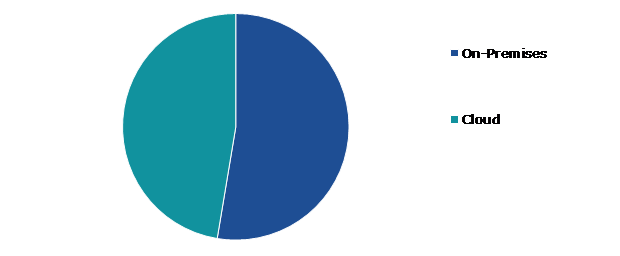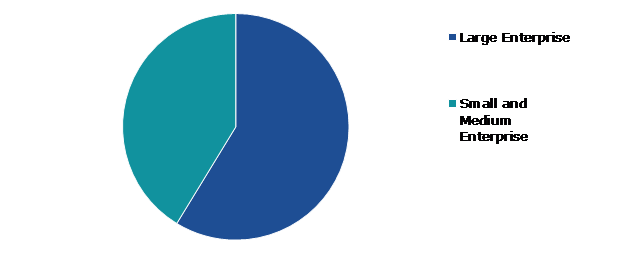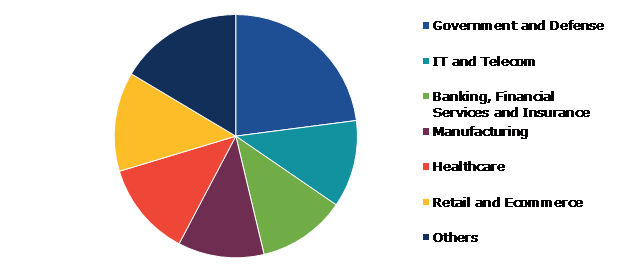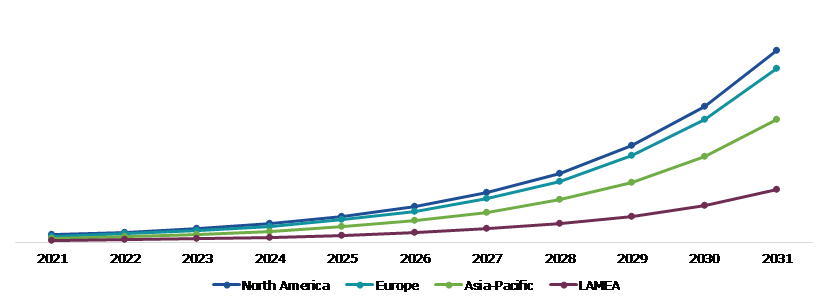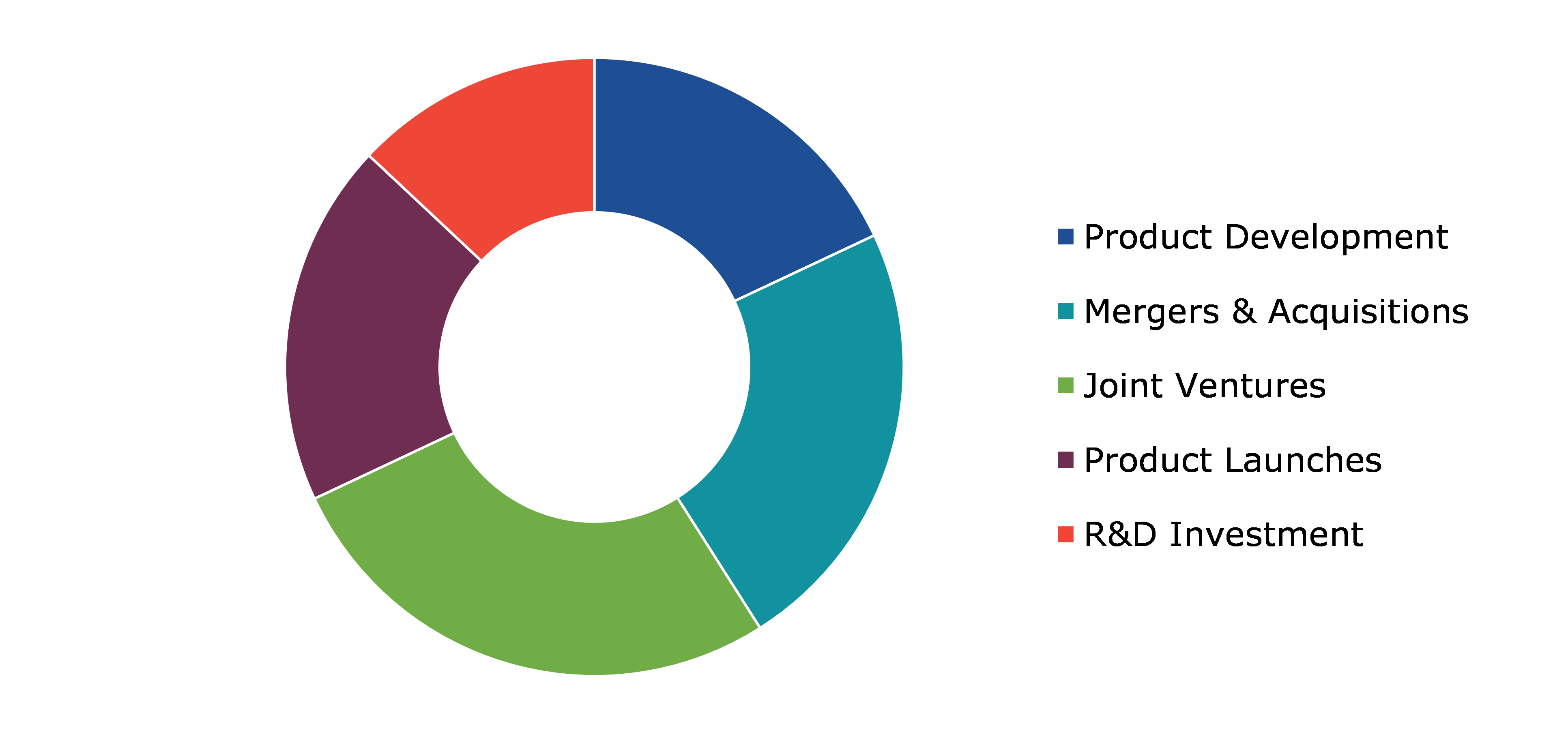Software Defined Perimeter Market Report
RA00080
Software Defined Perimeter Market by Connectivity (Controller, Gateway, and End point), Development Mode (On-premises and Cloud), Deployment Mode (On-Premises and Cloud), Organization Size (Large Enterprises and Small and Medium Enterprises), User Type (Government and Defense, Banking, IT and Telecom, Banking, Financial Services, and Insurance, Manufacturing, Healthcare, Retail and Ecommerce, and Others), and Regional Analysis (North America, Europe, Asia-Pacific, and LAMEA): Global Opportunity Analysis and Industry Forecast,2022-2031
Global Software Defined Perimeter Market Analysis
The Global Software Defined Perimeter Market Size was $5,308.1 million in 2021 and is predicted to grow with a CAGR of 39.3% by generating a revenue of $1,43,049.2 million by 2031.
Global Software Defined Perimeter Market Synopsis
The Software-Defined Perimeter (SDP) solutions offer the capability to deploy network security perimeter functionality where it is required to isolate services and applications deployed and accessed on unauthorized networks. These solutions are built to offer an on-demand and trusted overlay network isolated to mitigate network-based threats. When using SDP, assets are hidden from unauthorized parties, trust is built before connections are allowed, and the system is controlled by distinct control and data planes. It allows IT administrators to create boundaries around the network. They can be used in a variety of contexts, including the internet, hosting centers, the cloud, and private company networks. A Software defined perimeter is a means of protecting internet-connected equipment, such as routers and servers, from external users. It can be used to safeguard infrastructure, whether it is hosted in the cloud or on-premises. It is based on the use of software, rather than hardware, to secure an environment. Software defined perimeter functions are wider, and its installation method is simpler. One of the guiding concepts of software defined perimeters is that users cannot acquire access unless they are verified. This distinguishes it from access-based control configurations, which may enable a user to enter the network but restrict their rights until they validate their identity. The growing demand for security architecture and the increasing use of cloud-based systems are key factors propelling the software defined perimeter market growth. Future applications of this system could include military security and other diverse uses.
However, the major disadvantage of software defined perimeter is the fact that software defined perimeters are not the same as standard network security protocols. Adopting a software defined perimeter solution may cause network and infrastructure disruptions in large organizations due to the necessity of upgrading all devices and apps.
The software defined perimeter provides safety and other crucial benefits such as cost-effectiveness. It helps to lessen the complexities that occur while managing the systems. Owing to all these factors, the demand for software defined perimeter solutions is expected to augment in small and medium scale enterprises. This, in turn, is expected to offer excellent opportunities to market players during the forecast period.
According to regional analysis, the North America software defined perimeter market accounted for the largest market share in 2021. This is because the use of software defined perimeter security systems is rapidly increasing as a result of technological advancement and large-scale implementation of software defined perimeter security systems by several organizations in this region.
Software Defined Perimeter Overview
Software defined perimeter is the network security framework that safeguards cloud-based data and applications, permitting enterprises to limit network access and provide customized, managed, and protected access to networked systems. An SDP implementation hides assets and employs a single packet to set trust via a separate control and data plane before permitting connections to hidden assets.
COVID-19 Impact on Global Software Defined Perimeter Market
The COVID-19 pandemic created several uncertainties, resulting in significant economic losses as various businesses around the world came to a halt. Due to social distancing norms and statewide lockdowns, the COVID-19 pandemic has inevitably increased the usage of digital technologies. Globally, individuals and organizations have had to adapt to new ways of living and working. Lockdowns have increased the use of networks and information systems, as well as significant changes in usage habits and behaviors. Workers are adjusting to the new normal when meetings move entirely online, office work is done from home, and new work patterns emerge. Most organizations, whether in industry, society, or government, have experienced these shifts. As a result of the ongoing COVID-19 pandemic, several large to small-scale establishments around the world, particularly in the IT and digital marketing sectors, have shifted their operations to digital platforms and the cloud, which is expected to increase demand for software defined perimeter solutions in the coming years. While some IT businesses have stated that remote working will continue to be the standard during 2020 and the first quarter of 2021, the adoption of software defined perimeter solutions is expected to gain significant pace. With the pandemic, there has been a significant shift toward remote work, which has fueled interest in the software defined perimeter.
Growing Applications of Software Defined Perimeter in Cybersecurity to Drive the Market Growth
Technological developments are projected to have a significant influence on the overall development and uptake of software defined perimeter solutions. Over the past ten years, the software defined perimeter has become more popular as a means of defending against a variety of server vulnerabilities and network-based cyber threats. Players in the market for software defined perimeters are increasingly working to make their software defined perimeter solutions more effective at preventing security breaches. In addition, a software defined perimeter is becoming more popular since it works with a variety of gadgets, including laptops, desktop computers, cell phones, and other gadgets linked to the Internet of Things (IoT). Additionally, a software defined boundary greatly decreases the network attack surface.
To know more about global software defined perimeter market drivers, get in touch with our analysts here.
Lack of Awareness about Software Defined Perimeter Security is a Significant Restraint for the Growth of Software Defined Perimeter Market
The perimeter security market's growth is being hindered by a lack of understanding of security threats and the possible losses that could result. With little awareness of perimeter security, system integrators, and security experts attempt to integrate existing IT systems with sophisticated perimeter security, which could harm existing IT systems running on vital infrastructure. The key concern enterprises have right now is a lack of technical knowledge and security configuration, which makes it difficult for them to satisfy their changing perimeter security requirements. Many businesses employ security experts who are unable to understand the complex nature of perimeter security systems, which is anticipated to hamper the software defined perimeter market growth.
Development of Internet of Things is Expected to offer Ample Growth Opportunities
Software defined perimeter solutions simplify the configuration, management, and control of security infrastructure without needing a high level of protection. Furthermore, the rising adoption of cloud-based apps, strict legislation, and a highly qualified cybersecurity workforce is projected to drive the software defined perimeter market. This next-generation technology-integrated system has not only increased efficiency but further compelled manufacturers to develop new advanced software perimeter security systems. The software defined perimeter for IoT is dynamic, it is the best alternative to network controls and traditional firewalls, and it is projected to increase the growth of the market in the near future.
To know more about global software defined perimeter market opportunities, get in touch with our analysts here.
Global Software defined Perimeter Market, by Connectivity
Based on connectivity, the market has been divided into controller, gateway, and end point. Among these, the gateway sub-segment accounted for the highest market share in 2021 whereas the end point sub-segment is estimated to show the fastest growth during the forecast period.
Global Software Defined Perimeter Market Size, by Connectivity, 2021
Source: Research Dive Analysis
The gateway sub-type accounted for the highest market share in 2021. A gateway is a software defined perimeter network node that connects two networks that employ separate transmission protocols. The primary advantage of using a gateway in software-defined perimeter contexts is that it consolidates internet connectivity into a single device via a remote network. The gateway is installed at the network's edge and manages all data directed internally or outside of that network. Furthermore, gateways store information on the internal paths of the host network as well as the paths of any new networks found.
The end point sub-type is anticipated to show the fastest growth during the forecast period. Endpoints network are devices that people access remotely. It exchanges data with a network to which they are linked. It can take the form of desktop computers, laptop computers, tablets, cellphones, servers, and Internet of Things (IoT) devices. These machines serve as unprotected access points for cybercriminals. It is where hackers may execute code, exploit flaws, encrypt, and penetrate digital assets.
Global Software Defined Perimeter Market, by Deployment Mode
Based on deployment mode, the market has been divided into on-premises and cloud. Among these, the cloud sub-segment is expected to show a fastest CAGR during the forecast period.
Global Software Defined Perimeter Market Share, by Deployment Mode, 2021
Source: Research Dive Analysis
The cloud sub-segment is expected to show the fastest CAGR during the forecast period. Cloud computing enhances software defined perimeter outcomes by increasing productivity and cooperation. Employees, students, and contractors can access files at any time, from any location, and on any device. Cloud computing has been a major reason behind software-based workforce's untethered nature. It enables people to work, communicate, and cooperate virtually from anywhere, removing the need for recruiting and/or working locally. These factors are anticipated to boost the growth of the cloud sub-segment during the analysis timeframe.
Global Software Defined Perimeter Market, by Organization Size
Based on organization size, the market has been divided into large enterprise and small and medium enterprise. Among these, the large enterprise sub-segment accounted for the highest revenue share in 2021.
Global Software defined Perimeter Market Growth, by Organization Size, 2021
The Large Enterprise sub-segment accounted for the highest market share in 2021. Software defined perimeter requires multiple forms of authentication from users to establish whether they are safe to access the network. Large organizations can identify an unauthorized person even if the individual has authorized user credentials due to this twofold authentication. These firms have huge amounts of data, including financial, legal, and company data. This must be securely saved and utilized only by authorized personnel. software defined perimeter continuously observes the behavioral changes that occur in the environment when users accomplish various confidential tasks.
Global Software Defined Perimeter Market, by User Type
Based on user type, the market has been divided into government and defense, IT and telecom, banking, financial services and insurance, manufacturing, healthcare, retail and ecommerce, and others. Among these, the government and defense sub-segment accounted for the highest revenue share in 2021.
Global Software defined Perimeter Market Trends, by User Type, 2021
The government and defense sub-segment accounted for largest market share in 2021. This increase can be ascribed to the widespread use of software defined perimeter security systems in the government and defense sectors for weapon protection using surveillance, reconnaissance, and intelligence information. These systems necessitate the most dependable and advanced security system, which is projected to increase demand for software defined perimeter security solutions to secure government and defense sector data. The IT and telecommunications industries are expected to expand significantly.
Global Software Defined Perimeter Market, Regional Insights
The software defined perimeter market was investigated across North America, Europe, Asia-Pacific, and LAMEA.
Global Software Defined Perimeter Market Size & Forecast, by Region, 2021-2031 (USD Million)
Source: Research Dive Analysis
The Market for Software defined perimeter in North America to be the Most Dominant
The North America software defined perimeter accounted for the largest market share in 2021. The use of technological advancements and the region's early adoption of software defined perimeter drive demand for software-defined perimeters in North America. Governments in this region are implementing initiatives to establish a secure IT environment and safeguard critical data. Furthermore, compliance management is properly enforced in the region. Businesses need flexible and agile security solutions as data centers become more software driven. One of the factors driving demand for the market in the region is the fact that North America is highly dedicated to the research and development technology area, particularly in Canada and the U.S.
Competitive Scenario in the Global Software Defined Perimeter Market
Product development and joint ventures are common strategies followed by major market players. For instance, in December 2019, Palo Alto Networks bought Aporeto, a company that uses identity-based micro segmentation to reduce the possibility of lateral attacks.
Source: Research Dive Analysis
Some of the leading software defined perimeter market players are Fortinet, Inc., Catbird Networks, Inc., RSA Security LLC., Intel Corporation, Check Point Software Technologies Ltd., CERTES NETWORKS, Cisco Systems, Inc., Palo Alto Networks, Inc., Juniper Networks, Inc., and Broadcom.
| Aspect | Particulars |
| Historical Market Estimations | 2020 |
| Base Year for Market Estimation | 2021 |
| Forecast Timeline for Market Projection | 2022-2031 |
| Geographical Scope | North America, Europe, Asia-Pacific, LAMEA |
| Segmentation by Connectivity |
|
| Segmentation by Deployment Mode |
|
| Segmentation by Organization Size |
|
| Segmentation by User Type |
|
| Key Companies Profiled |
|
Q1. What is the size of the global software defined perimeter market?
A. The size of the global software defined perimeter market was over $5,308.1 million in 2021 and is projected to reach $1,43,049.2 million by 2031.
Q2. Which are the major companies in the software defined perimeter market?
A. Fortinet, Inc., Catbird Networks, Inc., and RSA Security LLC. are some of the key players in the global software defined perimeter market.
Q3. Which region, among others, possesses greater investment opportunities in the near future?
A. Asia-Pacific possesses great investment opportunities for investors to witness the most promising growth in the future.
Q4. What will be the growth rate of the Asia-Pacific software defined perimeter market?
A. Asia-Pacific software defined perimeter market is anticipated to grow at 40.2% CAGR during the forecast period.
Q5. What are the strategies opted by the leading players in this market?
A. Product development and joint ventures are the two key strategies opted by the operating companies in this market.
Q6. Which companies are investing more on R&D practices?
A. Check Point Software Technologies Ltd., Certes Networks, and Cisco Systems are the companies investing more on R&D activities for developing new products and technologies.
1.Research Methodology
1.1.Desk Research
1.2.Real time insights and validation
1.3.Forecast model
1.4.Assumptions and forecast parameters
1.5.Market size estimation
1.5.1.Top-down approach
1.5.2.Bottom-up approach
2.Report Scope
2.1.Market definition
2.2.Key objectives of the study
2.3.Report overview
2.4.Market segmentation
2.5.Overview of the impact of COVID-19 on Global software defined perimeter market
3.Executive Summary
4.Market Overview
4.1.Introduction
4.2.Growth impact forces
4.2.1.Drivers
4.2.2.Restraints
4.2.3.Opportunities
4.3.Market value chain analysis
4.3.1.List of raw material suppliers
4.3.2.List of manufacturers
4.3.3.List of distributors
4.4.Innovation & sustainability matrices
4.4.1.Technology matrix
4.4.2.Regulatory matrix
4.5.Porter’s five forces analysis
4.5.1.Bargaining power of suppliers
4.5.2.Bargaining power of consumers
4.5.3.Threat of substitutes
4.5.4.Threat of new entrants
4.5.5.Competitive rivalry intensity
4.6.PESTLE analysis
4.6.1.Political
4.6.2.Economical
4.6.3.Social
4.6.4.Technological
4.6.5.Environmental
4.7.Impact of COVID-19 on software defined perimeter market
4.7.1.Pre-covid market scenario
4.7.2.Post-covid market scenario
5.Software Defined Perimeter Market Analysis, by Connectivity
5.1.Overview
5.2.Controller
5.2.1.Definition, key trends, growth factors, and opportunities
5.2.2.Market size analysis, by region, 2021-2031
5.2.3.Market share analysis, by country, 2021-2031
5.3.Gateway
5.3.1. Definition, key trends, growth factors, and opportunities
5.3.2.Market size analysis, by region, 2021-2031
5.3.3.Market share analysis, by country, 2021-2031
5.4.End point
5.4.1. Definition, key trends, growth factors, and opportunities
5.4.2.Market size analysis, by region, 2021-2031
5.4.3.Market share analysis, by country, 2021-2031
5.4.4.Research Dive Exclusive Insights
5.5.Research Dive Exclusive Insights
5.5.1.Market attractiveness
5.5.2.Competition heatmap
6.Software Defined Perimeter Market Analysis, by Deployment Mode
6.1.Overview
6.2.On-Premises
6.2.1.Definition, key trends, growth factors, and opportunities
6.2.2.Market size analysis, by region, 2021-2031
6.2.3.Market share analysis, by country, 2021-2031
6.3.Cloud
6.3.1.Definition, key trends, growth factors, and opportunities
6.3.2.Market size analysis, by region, 2021-2031
6.3.3.Market share analysis, by country, 2021-2031
6.4.Research Dive Exclusive Insights
6.4.1.Market attractiveness
6.4.2.Competition heatmap
7.Software Defined Perimeter Market Analysis, by Organization Size
7.1.Overview
7.2.Large Enterprise
7.2.1.Definition, key trends, growth factors, and opportunities
7.2.2.Market size analysis, by region, 2021-2031
7.2.3.Market share analysis, by country, 2021-2031
7.3.Small and Medium Enterprise
7.3.1.Definition, key trends, growth factors, and opportunities
7.3.2.Market size analysis, by region, 2021-2031
7.3.3.Market share analysis, by country, 2021-2031
7.4.Research Dive Exclusive Insights
7.4.1.Market attractiveness
7.4.2.Competition heatmap
8.Software Defined Perimeter Market Analysis, by User Type
8.1.Overview
8.2.Government and Defense
8.2.1.Definition, key trends, growth factors, and opportunities
8.2.2.Market size analysis, by region, 2021-2031
8.2.3.Market share analysis, by country, 2021-2031
8.3.IT and Telecom
8.3.1.Definition, key trends, growth factors, and opportunities
8.3.2.Market size analysis, by region, 2021-2031
8.3.3.Market share analysis, by country, 2021-2031
8.4.Banking, Financial Services and Insurance
8.4.1.Definition, key trends, growth factors, and opportunities
8.4.2.Market size analysis, by region, 2021-2031
8.4.3.Market share analysis, by country, 2021-2031
8.5.Manufacturing
8.5.1.Definition, key trends, growth factors, and opportunities
8.5.2.Market size analysis, by region, 2021-2031
8.5.3.Market share analysis, by country, 2021-2031
8.6.Healthcare
8.6.1.Definition, key trends, growth factors, and opportunities
8.6.2.Market size analysis, by region, 2021-2031
8.6.3.Market share analysis, by country, 2021-2031
8.7.Retail and Ecommerce
8.7.1.Definition, key trends, growth factors, and opportunities
8.7.2.Market size analysis, by region, 2021-2031
8.7.3.Market share analysis, by country, 2021-2031
8.8.Others
8.8.1.Definition, key trends, growth factors, and opportunities
8.8.2.Market size analysis, by region, 2021-2031
8.8.3.Market share analysis, by country, 2021-2031
8.9.Research Dive Exclusive Insights
8.9.1.Market attractiveness
8.9.2.Competition heatmap
9.Software Defined Perimeter Market, by Region
9.1.North America
9.1.1.U.S.
9.1.1.1.Market size analysis, by connectivity, 2021-2031
9.1.1.2.Market size analysis, by deployment mode, 2021-2031
9.1.1.3.Market size analysis, by organization size, 2021-2031
9.1.1.4.Market size analysis, by user type, 2021-2031
9.1.2.Canada
9.1.2.1.Market size analysis, by connectivity, 2021-2031
9.1.2.2.Market size analysis, by deployment mode, 2021-2031
9.1.2.3.Market size analysis, by organization size, 2021-2031
9.1.2.4.Market size analysis, by user type, 2021-2031
9.1.3.Mexico
9.1.3.1.Market size analysis, by connectivity, 2021-2031
9.1.3.2.Market size analysis, by deployment mode, 2021-2031
9.1.3.3.Market size analysis, by organization size, 2021-2031
9.1.3.4.Market size analysis, by user type, 2021-2031
9.1.4.Research Dive Exclusive Insights
9.1.4.1.Market attractiveness
9.1.4.2.Competition heatmap
9.2.Europe
9.2.1.Germany
9.2.1.1.Market size analysis, by connectivity, 2021-2031
9.2.1.2.Market size analysis, by deployment mode, 2021-2031
9.2.1.3.Market size analysis, by organization size, 2021-2031
9.2.1.4.Market size analysis, by user type, 2021-2031
9.2.2.UK
9.2.2.1.Market size analysis, by connectivity, 2021-2031
9.2.2.2.Market size analysis, by deployment mode, 2021-2031
9.2.2.3.Market size analysis, by organization size, 2021-2031
9.2.2.4.Market size analysis, by user type, 2021-2031
9.2.3.France
9.2.3.1.Market size analysis, by connectivity, 2021-2031
9.2.3.2.Market size analysis, by deployment mode, 2021-2031
9.2.3.3.Market size analysis, by organization size, 2021-2031
9.2.3.4.Market size analysis, by user type, 2021-2031
9.2.4.Spain
9.2.4.1.Market size analysis, by connectivity, 2021-2031
9.2.4.2.Market size analysis, by deployment mode, 2021-2031
9.2.4.3.Market size analysis, by organization size, 2021-2031
9.2.4.4.Market size analysis, by user type, 2021-2031
9.2.5.Italy
9.2.5.1.Market size analysis, by connectivity, 2021-2031
9.2.5.2.Market size analysis, by deployment mode, 2021-2031
9.2.5.3.Market size analysis, by organization size, 2021-2031
9.2.5.4.Market size analysis, by user type, 2021-2031
9.2.6.Rest of Europe
9.2.6.1.Market size analysis, by connectivity, 2021-2031
9.2.6.2.Market size analysis, by deployment mode, 2021-2031
9.2.6.3.Market size analysis, by organization size, 2021-2031
9.2.6.4.Market size analysis, by user type, 2021-2031
9.2.7.Research Dive Exclusive Insights
9.2.7.1.Market attractiveness
9.2.7.2.Competition heatmap
9.3.Asia Pacific
9.3.1.China
9.3.1.1.Market size analysis, by connectivity, 2021-2031
9.3.1.2.Market size analysis, by deployment mode, 2021-2031
9.3.1.3.Market size analysis, by organization size, 2021-2031
9.3.1.4.Market size analysis, by user type, 2021-2031
9.3.2.Japan
9.3.2.1.Market size analysis, by connectivity, 2021-2031
9.3.2.2.Market size analysis, by deployment mode, 2021-2031
9.3.2.3.Market size analysis, by organization size, 2021-2031
9.3.2.4.Market size analysis, by user type, 2021-2031
9.3.3.India
9.3.3.1.Market size analysis, by connectivity, 2021-2031
9.3.3.2.Market size analysis, by deployment mode, 2021-2031
9.3.3.3.Market size analysis, by organization size, 2021-2031
9.3.3.4.Market size analysis, by user type, 2021-2031
9.3.4.Australia
9.3.4.1.Market size analysis, by connectivity, 2021-2031
9.3.4.2.Market size analysis, by deployment mode, 2021-2031
9.3.4.3.Market size analysis, by organization size, 2021-2031
9.3.4.4.Market size analysis, by user type, 2021-2031
9.3.5.South Korea
9.3.5.1.Market size analysis, by connectivity, 2021-2031
9.3.5.2.Market size analysis, by deployment mode, 2021-2031
9.3.5.3.Market size analysis, by organization size, 2021-2031
9.3.5.4.Market size analysis, by user type, 2021-2031
9.3.6.Rest of Asia Pacific
9.3.6.1.Market size analysis, by connectivity, 2021-2031
9.3.6.2.Market size analysis, by deployment mode, 2021-2031
9.3.6.3.Market size analysis, by organization size, 2021-2031
9.3.6.4.Market size analysis, by user type, 2021-2031
9.3.7.Research Dive Exclusive Insights
9.3.7.1.Market attractiveness
9.3.7.2.Competition heatmap
9.4.LAMEA
9.4.1.Brazil
9.4.1.1.Market size analysis, by connectivity, 2021-2031
9.4.1.2.Market size analysis, by deployment mode, 2021-2031
9.4.1.3.Market size analysis, by organization size, 2021-2031
9.4.1.4.Market size analysis, by user type, 2021-2031
9.4.2.Saudi Arabia
9.4.2.1.Market size analysis, by connectivity, 2021-2031
9.4.2.2.Market size analysis, by deployment mode, 2021-2031
9.4.2.3.Market size analysis, by organization size, 2021-2031
9.4.2.4.Market size analysis, by user type, 2021-2031
9.4.3.UAE
9.4.3.1.Market size analysis, by connectivity, 2021-2031
9.4.3.2.Market size analysis, by deployment mode, 2021-2031
9.4.3.3.Market size analysis, by organization size, 2021-2031
9.4.3.4.Market size analysis, by user type, 2021-2031
9.4.4.South Africa
9.4.4.1.Market size analysis, by connectivity, 2021-2031
9.4.4.2.Market size analysis, by deployment mode, 2021-2031
9.4.4.3.Market size analysis, by organization size, 2021-2031
9.4.4.4.Market size analysis, by user type, 2021-2031
9.4.5.Rest of LAMEA
9.4.5.1.Market size analysis, by connectivity, 2021-2031
9.4.5.2.Market size analysis, by deployment mode, 2021-2031
9.4.5.3.Market size analysis, by organization size, 2021-2031
9.4.5.4.Market size analysis, by user type, 2021-2031
9.4.6.Research Dive Exclusive Insights
9.4.6.1.Market attractiveness
9.4.6.2.Competition heatmap
10.Competitive Landscape
10.1.Top winning strategies, 2021
10.1.1.By strategy
10.1.2.By year
10.2.Strategic overview
10.3.Market share analysis, 2021
11.Company Profiles
11.1.Fortinet, Inc.
11.1.1.Overview
11.1.2.Business segments
11.1.3.Product portfolio
11.1.4.Financial performance
11.1.5.Recent developments
11.1.6.SWOT analysis
11.1.7.Research dive analyst view
11.2.Catbird Networks, Inc.
11.2.1.Overview
11.2.2.Business segments
11.2.3.Product portfolio
11.2.4.Financial performance
11.2.5.Recent developments
11.2.6.SWOT analysis
11.2.7.Research dive analyst view
11.3.RSA Security LLC.
11.3.1.Overview
11.3.2.Business segments
11.3.3.Product portfolio
11.3.4.Financial performance
11.3.5.Recent developments
11.3.6.SWOT analysis
11.3.7.Research dive analyst view
11.4.Intel Corporation
11.4.1.Overview
11.4.2.Business segments
11.4.3.Product portfolio
11.4.4.Financial performance
11.4.5.Recent developments
11.4.6.SWOT analysis
11.4.7.Research dive analyst view
11.5.Check Point Software Technologies Ltd.
11.5.1.Overview
11.5.2.Business segments
11.5.3.Product portfolio
11.5.4.Financial performance
11.5.5.Recent developments
11.5.6.SWOT analysis
11.5.7.Research dive analyst view
11.6.CERTES NETWORKS
11.7.Cisco Systems, Inc.
11.7.1.Overview
11.7.2.Business segments
11.7.3.Product portfolio
11.7.4.Financial performance
11.7.5.Recent developments
11.7.6.SWOT analysis
11.7.7.Research dive analyst view
11.8.Palo Alto Networks, Inc.
11.8.1.Overview
11.8.2.Business segments
11.8.3.Product portfolio
11.8.4.Financial performance
11.8.5.Recent developments
11.8.6.SWOT analysis
11.8.7.Research dive analyst view
11.9.Juniper Networks, Inc.
11.9.1.Overview
11.9.2.Business segments
11.9.3.Product portfolio
11.9.4.Financial performance
11.9.5.Recent developments
11.9.6.SWOT analysis
11.9.7.Research dive analyst view
11.10.Broadcom
11.10.1.Overview
11.10.2.Business segments
11.10.3.Product portfolio
11.10.4.Financial performance
11.10.5.Recent developments
11.10.6.SWOT analysis
11.10.7.Research dive analyst view
Software-defined parameter is a virtual software-based boundary that is designed to hide the internet-connected infrastructure so as to protect it from external actors and threats. Thus, instead of creating a network-based perimeter on hardware, the software-defined parameter creates a protected ecosystem of its own which helps in limiting network access, hiding access to critical infrastructure, and managing data within the ecosystem.
Forecast Analysis of the Market
In recent years, there has been an increase in cybersecurity threats which has led to a growth in demand for software defined perimeters. This growth in demand and usage is expected to be the primary growth driver for the software defined perimeter market in the forecast years. Along with this, increasing use of cloud-based systems is expected to push the market further. Also, development of advanced technologies such as Internet of Things is predicted to offer numerous investment and growth opportunities to the market in the analysis timeframe. However, lack of awareness regarding software defined perimeter security may restrain the growth of the software defined perimeter market in the forecast period.
Regionally, the software defined perimeter market in the North America region is expected to be the most dominant by 2031. Growing adoption of network technology by private players and government agencies in various countries of this region is anticipated to become the main growth driver of the market in the forecast period.
According to the report published by Research Dive, the global software defined perimeter market is expected to gather a revenue of $1,43,049.2 million by 2031 and grow at 39.3% CAGR in the 2022-2031 timeframe. Some prominent market players include Fortinet, Inc., Check Point Software Technologies Ltd., Palo Alto Networks, Inc., Catbird Networks, Inc., CERTES NETWORKS, Juniper Networks, Inc., RSA Security LLC., Broadcom, M Intel Corporation, Cisco Systems, Inc., and many others.
Covid-19 Impact on the Software Defined Perimeter Market
The outbreak of the Covid-19 pandemic has had a massive negative effect on almost all industries and businesses across the world. The software defined perimeter market, however, proved to be an exception. The lockdowns and travel restriction invariably increased the demand and use of digital technologies. Moreover, various IT companies shifted their databases to cloud systems which necessitated the use of software defined parameters to protect their data from external threats. This increase in demand for software defined parameters helped the market to grow during the pandemic years.
Significant Market Developments
The significant companies operating in the industry are adopting numerous growth strategies & business tactics such as partnerships, collaborations, mergers & acquisitions, and launches to maintain a robust position in the overall market, thus helping the software defined perimeter market to flourish. For instance:
- In November 2021, BlastWave, a leading developer of software defined parameter solutions, launched BlastShield™, a first-of-its-kind, all-in-one software defined parameter solution. This password-less SDP solution runs on a zero-trust security model. This product launch is anticipated to help BlastWave to cater to the demands of the information technology sector in a much better way.
- In July 2022, Johnson Controls, a multinational automation company, announced Tempered Networks, a cybersecurity provider. Tempered Networks recently gained a lot of praise and limelight for developing ‘Airwall’ technology, an advanced self-defense system for networks. This acquisition by Johnson Controls is, thus, predicted to help the company to increase its market share substantially in the next few years.
Personalize this research
- Triangulate with your own data
- Request your format and definition
- Get a deeper dive on a specific application, geography, customer or competitor
- + 1-888-961-4454 Toll - Free
- support@researchdive.com

